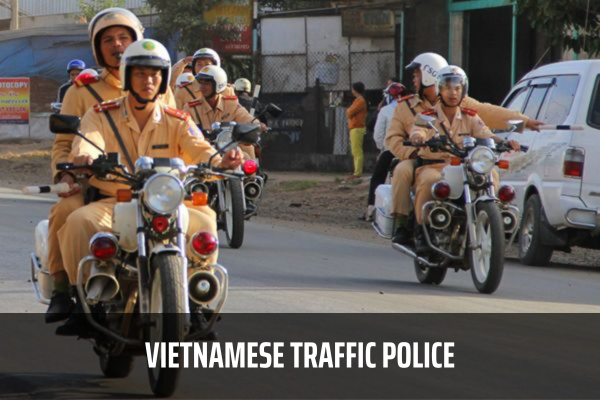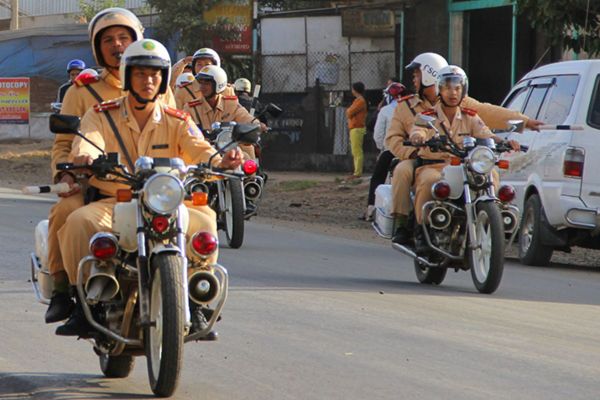What types of guns are Vietnamese traffic police equipped with when patrolling and controlling road traffic?
What types of guns are Vietnamese traffic police equipped with when patrolling and controlling road traffic?
Pursuant to the regulations in Clause 3 of Article 13 of Circular 32/2023/TT-BCA, which stipulates the uniforms, equipment, vehicles, technical equipment, weapons, and supportive tools of Traffic Police during patrols and inspections, the following is stated:
Uniforms, equipment, vehicles, technical equipment, weapons, and supportive tools of Traffic Police during patrols and inspections
...
3. Weapons and supportive tools include: Handguns, rifles, submachine guns, electric shock guns, net guns, rubber bullet guns, pepper spray guns, marking bullet guns, pepper spray canisters, electric batons, body armor, number 8 locks, and traffic control batons.
...
Therefore, based on the above regulations, starting from September 15, 2023, Traffic Police will be equipped with 8 types of guns for patrols and inspections, including:
- Handguns
- Rifles
- Submachine guns
- Electric shock guns
- Net guns
- Rubber bullet guns
- Pepper spray guns
- Marking bullet guns.

What types of guns are Vietnamese traffic police equipped with when patrolling and controlling road traffic? (Image from the Internet)
What are the cases where Vietnamese traffic police are allowed to stop vehicles?
Pursuant to the provisions in Clause 1 of Article 16 of Circular 32/2023/TT-BCA, which stipulates the 4 cases in which Traffic Police are allowed to stop vehicles during planned traffic patrols and inspections, the following are stated:
- Directly detecting or through the use of technical equipment, discovering and collecting evidence of violations of road traffic laws and other legal violations.
- Implementing orders and plans for overall traffic control to ensure road traffic order, safety, and social order; implementing plans for patrols, inspections, and handling of violations in accordance with specialized topics to ensure road traffic order, safety, and social order as authorized by competent agencies.
- Having a written request from the Chief or Deputy Chief of the investigating agency; written requests from relevant functional agencies to stop vehicles for control purposes in order to serve the work of ensuring security, order; combating crimes; preventing and responding to natural disasters, fires, epidemics; rescue and other legal violations. The written request must specify the specific time, route, and vehicles to be stopped for control and the participating forces.
- Receiving reports, feedback, suggestions, and accusations from organizations and individuals regarding violations of laws by individuals and vehicles participating in road traffic.
What is the process of control by Vietnamese traffic police?
Pursuant to the provisions in Article 18 of Circular 32/2023/TT-BCA, which regulates the process of control by traffic police, the following steps are to be followed:
Step 1: Request the vehicle operator to take safety measures and disembark from the vehicle.
Step 2: Greet the individual in accordance with the Regulations of the People's Police (except in cases where there is prior knowledge of the person engaging in criminal behavior, committing a crime, or being subject to an arrest warrant). When interacting with individuals who have committed legal violations, traffic police officers must maintain the correct posture, demeanor, and appropriate behavior.
Step 3: Inform the vehicle operator and the individuals on the vehicle about the reason for the control; request the vehicle operator to present relevant documents or information from electronic identification accounts.
Step 4: Perform control activities as stated in Clause 2, Article 12 of Circular 32/2023/TT-BCA, which include:
- Controlling documents related to individuals and vehicles.
- Controlling the conditions for participation in traffic for the vehicle.
- Controlling compliance with the regulations on road transport safety.
- Controlling other related matters as stipulated by the law.
For vehicles carrying more than 10 passengers or vehicles with dimensions equivalent to a vehicle carrying more than 10 passengers, the control must be conducted directly inside the passenger compartment, and the results of the control must be communicated.
Step 5: Conclude the control.
The traffic police officer reports the control results to the team leader, informs the vehicle operator and the individuals on the vehicle about the control results, any violations (if applicable), and the measures taken.
*Note:
If there is a basis to believe that a person, vehicle, or object involved in traffic has concealed evidence, vehicles, or documents used for administrative violations, a search of the person, vehicle, or object can be conducted in accordance with the law to handle administrative violations.
In case signs of criminal activity are discovered, the procedures stipulated by the criminal procedural law will be followed.
LawNet
